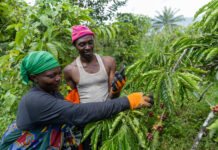Reduced soil health and stability have been a growing problem across Africa’s agricultural sector, significantly threatening the continent’s food security, environment and economic prosperity. With African smallholder farmers wondering what they can do to increase their yields, cover crops become a viable solution.
Cover cropping is a sustainable farming practice for preventing soil erosion and enriching the dirt with vital nutrients for plant growth. Their deep roots break up compacted soil and improve moisture retention — dire for a continent facing increasing droughts and excessive heat waves. Could cover crops be the missing component for protecting soil in one of the most critical agricultural regions in the world?
African Farmers at a Crossroads With Soil Quality
Agriculture is a pillar of Africa’s economy, employing 43% of its working class and accounting for 17% of its gross domestic product (GDP). In fact, Sierra Leone contributed over 60% of Africa’s GDP from 2020 to 2022, followed by Niger and Ethiopia at 42% and 38%, respectively.
Yet, African farmers struggle to yield enough crops to feed the growing population. Amid climate change impacts and unsustainable farming practices, the agricultural sector has grappled with poor soil quality and significant erosion.
Nearly 6.5 million hectares of farmland — about 16.1 million acres — are abandoned annually because of soil erosion. In Ethiopia, soil loss is extensive and a direct result of removing vegetation for wood, crops and livestock.
Soil health has also dwindled. About 25 years ago, one Kenyan farmer, Benson Wanjala, could harvest 200 bags of maize — today, he can only yield 30 bags. Wanjala blames the rise of synthetic fertilizers, which caused 63% of Kenya’s fertile land to become acidic just in the last few years. The effects negatively impacted the country’s horticulture and tea exports, while maize production fell by 4% in 2022.
Unlike places like the United Kingdom, African farmers struggle to make an adequate living in agriculture. This is partly due to receiving a much smaller share of the consumer price and bearing the costs of crop disease, pests and climate change.
Rather than rotating crops, applying environmentally safe fertilizers and pesticides, and giving soil a much-needed break from continuous crop cultivation, they’ve adopted monoculture, which significantly degrades and depletes its nutrients.
Maximizing Soil Health and Stability With Cover Crops
Cover crops are species like grasses, legumes and herbaceous flowers that deliver seasonal ground cover. Farmers may remove them manually through various methods, including chemicals, tillage and cutting. Otherwise, they allow them to die off naturally with the frost.
Globally, farmers have utilized cover crops as an excellent nature-based solution for enhancing soil quality and stability. In one study conducted at a vineyard in Spain, researchers determined soil erosion was 3.6 times higher in plots with fewer cover crops, whereas harvests from well-covered plots faired much better.
In another study from northern China, cover crops boosted hydrolyzable nitrogen by 29% within the first 20 centimeters of soil, greatly improving yields. Research findings also showed increased phosphorus and potassium due to cover cropping and plant diversity. The study showed nutrient density in topsoil was most prevalent with legume cover crops.
Cover crops are just as essential for managing pests and diseases ravaging African agriculture. Africa loses half of its yields to anthropods, diseases and weeds annually. In 2016, African smallholder farms were inundated with neo-tropical fall armyworms, while locusts swarmed in 2019.
Cover cropping can help prevent soil-borne pests and disease. For instance, using cabbages as cover crops in Wales and Lower Saxony, Germany, decreases bacteria, fungi and nematodes affecting sugar beets. Oat cover crops have also been known to limit nematodes and bacteria in potato production.
Of course, although not a cover crop, mulch plays a vital role in protecting the soil. A 3-inch layer of bark mulch over topsoil will help it retain moisture and raise the soil temperature. Farmers may also decide to use mulch in addition to cover crops or afterward to prevent weeds.
Cover Crop Solutions in African Agriculture
Cover crops are much more affordable than investments in cutting-edge agricultural technologies — this proves critical to resource-depleted and financially burdened African smallholder farmers.
Farmsteads in northern Benin have had impressive results with brown hemp, Crotalaria flowers and legumes. Brachiaria ruziziensis — Congo grass — has also performed well, with well-covered plots retaining 7%–13% moisture and sprouting fewer weeds.
Experts generally recommend planting five or more cover crop species together — from the cabbage, grass and cereal families — to ensure more biodiverse organic matter. Dolichos beans — a type of legume — are especially capable of adapting to varying climate conditions, pH levels between 4.4 and 7.8 and soil varieties. It also holds up well in droughts, which have tremendously affected the Horn of Africa in recent years.
Other options include fodder rye, black oats and fodder radish. Black oats can endure low soil pH and balance calcium levels, while fodder radish is immune to clubroot and similar diseases. It also helps aerate the soil when it cracks open.
Cover Cropping: An Essential Solution for Sustainable African Agriculture
Climate change impacts will continue to wreak havoc on African smallholder farms as the agriculture sector desperately tries to ramp up yields. Consequently, the continuation of conventional farming techniques will diminish soil fertility and stability, posing a threat to the food supply.
Cover cropping is a sustainable, feasible solution to preventing erosion and reduced soil quality for optimal plant growth. Smallholder farmers in African countries can enhance soil’s nutritional density and solidity by planting cover crops.








